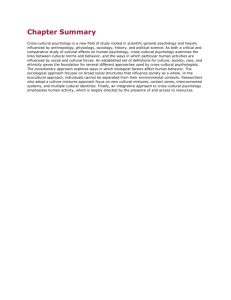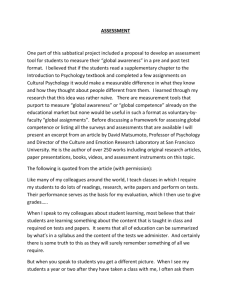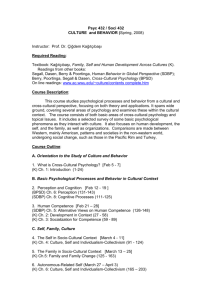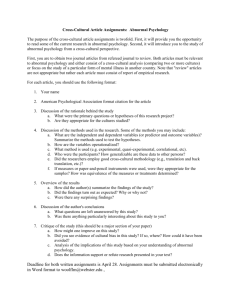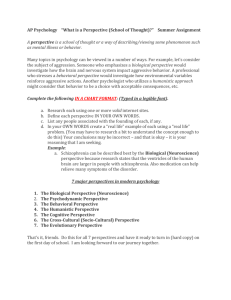Psyc 461 002 Weigl - Courses and Syllabi
advertisement
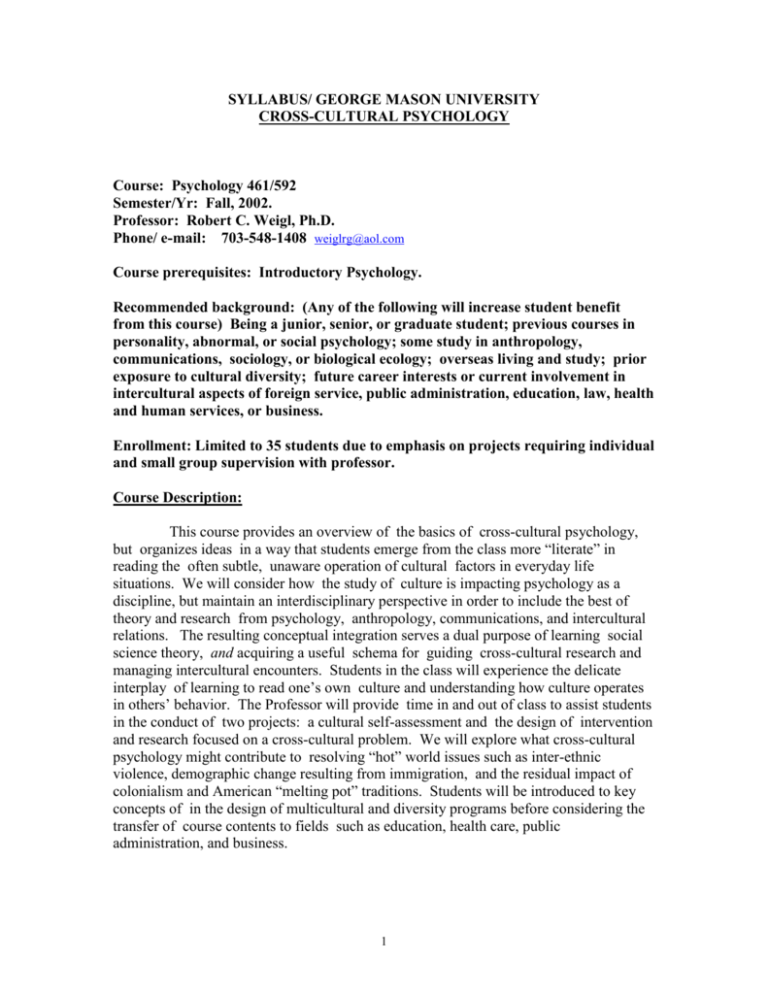
SYLLABUS/ GEORGE MASON UNIVERSITY CROSS-CULTURAL PSYCHOLOGY Course: Psychology 461/592 Semester/Yr: Fall, 2002. Professor: Robert C. Weigl, Ph.D. Phone/ e-mail: 703-548-1408 weiglrg@aol.com Course prerequisites: Introductory Psychology. Recommended background: (Any of the following will increase student benefit from this course) Being a junior, senior, or graduate student; previous courses in personality, abnormal, or social psychology; some study in anthropology, communications, sociology, or biological ecology; overseas living and study; prior exposure to cultural diversity; future career interests or current involvement in intercultural aspects of foreign service, public administration, education, law, health and human services, or business. Enrollment: Limited to 35 students due to emphasis on projects requiring individual and small group supervision with professor. Course Description: This course provides an overview of the basics of cross-cultural psychology, but organizes ideas in a way that students emerge from the class more “literate” in reading the often subtle, unaware operation of cultural factors in everyday life situations. We will consider how the study of culture is impacting psychology as a discipline, but maintain an interdisciplinary perspective in order to include the best of theory and research from psychology, anthropology, communications, and intercultural relations. The resulting conceptual integration serves a dual purpose of learning social science theory, and acquiring a useful schema for guiding cross-cultural research and managing intercultural encounters. Students in the class will experience the delicate interplay of learning to read one’s own culture and understanding how culture operates in others’ behavior. The Professor will provide time in and out of class to assist students in the conduct of two projects: a cultural self-assessment and the design of intervention and research focused on a cross-cultural problem. We will explore what cross-cultural psychology might contribute to resolving “hot” world issues such as inter-ethnic violence, demographic change resulting from immigration, and the residual impact of colonialism and American “melting pot” traditions. Students will be introduced to key concepts of in the design of multicultural and diversity programs before considering the transfer of course contents to fields such as education, health care, public administration, and business. 1 Course Objectives: 1. To illustrate the impact of cross-cultural studies on the development of psychology as a discipline. 2. To acquaint students with the most important theoretical and research developments in cross-cultural psychology during the past thirty years. 3. To integrate theory and lessons from research into a coherent schema to guide field research and interventions in intercultural situations. 4. To understand the interplay between study of one’s own and others’ culture. 5. To illustrate ways to use course material in a variety of applied settings. 6. To help students integrate course material into their educational and career plans. Methods of Evaluation: Two quizzes: 20% Cultural Self-Assessment report: 20% Research-Intervention Project: 25% Final Exam: 15% Class participation: 20% As your instructor, I place a heavy emphasis on class participation—sometimes greater than the 20% indicated above when contributions are outstanding or, on the other hand, when people do not come to class. Class attendance is critical; as your teacher I go far beyond material in your assigned readings. Also, the effectiveness of our work together depends on you drawing on your own experiences to comment on ideas presented in class. The intercultural experiences of students adds tremendously to everyone’s learning in class. I encourage students to meet with me during office hours, or before after class especially for help with the projects and for assistance in seeing the connection between the class and future work and study plans. In grading, I will hold graduate students to higher standards than those applied to undergraduates. I believe evaluation should flow in both directions in the classroom. While I evaluate your work, I would like to maintain a steady flow of feedback from you about the course and my teaching. I will ask you to evaluate me at least twice during, as well as at the close of the semester. I would also like to ask that we have one undergraduate and one graduate consultant to help maintain a steady flow of feedback about student experiences in class. I will ask all students to report their concerns to the consultants, who, in turn will relay them anonymously to me. I will also ask these consultants to keep me posted about typical GMU workloads, grading conventions, and student needs. 2 Readings and Resources: The two following books are your texts and should be purchased for the class: ***Berry, J.W., Portinga, Y.H., Segall, M.H., Dasen P.P. (2002) Cross-cultural Psychology: Research and Applications. Second Edition. New York: Cambridge University Press You will be among the very first students in the U.S. to use this just released second edition of what is the best single volume coverage of the field. This text is difficult reading for those who do not have an extensive background in psyhcology. Not all of reading from this book will be discussed in lectures; please ask, in and out of class, for explanations of parts of the text you do not understand. ***Hall, Edward T. (1976) Beyond Culture. New York: Doubleday Anchor Books. This is a great classic in intercultural theory and applied work. It is relatively easy reading, though some content and illustrations will seem out-of-date. The following article will be on library reserve, or I will have copies for students to copy. You should have a hard copy for your own use. Many previous students have have said it was the most important reading in the course. ***Bennett, Milton J. Towards Ethnorelativism: A Developmental Model of Intercultural Sensitivity. In Paige, R.M. (1993) Education for the Intercultural Experience (2nd ed.) Yarmouth, ME: Intercultural Press. 51pp. The following books are on reserve in the library, will be used for some reading assignments, but are primarily resources for your projects. Also, during the semester I will be placing additional articles on reserve. Bernal, M.E. & Knight, G.P. (Eds.) (1993.) Ethnic identity: formation and transmission among Hispanics and other minorities. Albany, N.Y.: State University of New York Press. Berry, J.W.; Poortinga, Y.H.. et. al. (Eds) (1997) Handbook of Cross-Cultural Psychology. 2nd Ed. 3 Volumes. Boston: Allyn and Bacon. Castillo, R.J. (1997) Culture and Mental Illness: A Client-Centered Approach. Pacific Grove, CA: Brooks Cole. 3 Cole, M. (1996) Cultural psychology: a once and future discipline. Cambridge, MA: The Belknap Press of Harvard University Press. Landis, D. & Bhagat, R.S. (Eds.) (1996) Handbook of intercultural training. 2nd Edition. Thousand Oaks, CA: Sage Publications. McGoldrick, M., Giordano, J., and Pearce, J.K. (1996) Ethnicity and Family Therapy. 2nd Edition. New York, Guilford Press. Matsumoto, D. (Ed.) (2001) Handbook of Culture and Psychology. Oxford, England: Oxford University Press. Moghaddam, F.M. (1998) Social Psychology: Exploring Universals Across Cultures. New York: W.H. Freeman and Company. Paige, R.M. (Ed.) (1993) Education for the Intercultural Experience. 2nd Edition. Yarmouth, ME, Intercultural Press. Roland, A. (1988) In Search of Self in India and Japan: Toward a Cross-Cultural Psychology. Princeton, NJ: Princeton University Press. Samovar, L.A. and Porter, R.E. (1995) Communications Between Cultures :2nd Edition. New York: Wadsworth Publishing Shweder, R.A. (1991) Thinking Through Cultures: Expeditions in Cultural Psychology. Cambridge, MA: Harvard Univeristy Press. Triandis, H.C. (1994) Culture and Social Behavior. New York: McGraw Hill. Ward, C.A. (1989) Altered States of Consciousness and Mental Health: A Cross-Cultural Perspective. Newbury Park, CA: Sage Publications. Weaver, G.R. Ed. (1998) Culture, Communication, and Conflict: Readings in Intercultural Relations 2nd Edition. Needham Heights, MA: Simon & Schuster. Films: Three films are on reserve at the media desk at the library. Films 1 and 3 are required viewing; film 2 is recommended. 1.East is East (2000) With striking funny and painful elements, this film shows the struggles of a bi-cultural Pakistani and English family adapting to working class England. 2.The Last Wave (1977) A young attorney (Richard Chamberlain) navigates the mysterious and often bizarre divide between British and aboriginal cultures in Asutralia 3. Before the Rain. (1995) Three interweaving stories portray the escalating violence between Christian and Islamic ethnic groups in a small community in Macedonia. 4 Classes and Readings: The following is a list of classes and readings for each. Classes are numbered, rather than given dates. Each class unit is designed as one day’s meeting and class work. “H” readings are in Hall, “B” readings in Berry et. al. Reserves and handouts as indicated. Readings are heavy at the outset and decrease as the course progresses. A. Foundations of Observable Culture. 1. Introduction: How can cross-cultural psychology be made useful? B:1-15; 225-233. 2. Biological, ecological, and historical factors. H:9-24; 41-55. B:255-265. 3. Language: Syntax for behavior. H: 57-69; B: 147-154; Samovar and Porter (on reserve) 180-215. 4. People and their scripts and settings: a naturalist’s field guide. H: 71-103,129-167; B: 53-71; 271-283. 5. Conceptual dimensions for the analysis of culture. H: 105-116; read handout; View film #1. 6. Applying conceptual dimensions in the field. B: 233-241; 287-294; 301-304. 7. Intelligence and situated competence. B: 115-130. B. Approaches to Subjective Culture. 8. Personalities and natural selection. H: 223-240; B: 86-113. 9. Beliefs, values, world views. B: 40-43,59-65; Samovar and Porter: Scan 77-142 for key concepts. 10. Cognitivist approaches. B: 71-73; 131-146; 249-253. 11. Motives, moods, and emotions. H: 213-222. B:172-195 QUIZ AFTER THIS CLASS. 12. Religion as an expression and guardian of culture. View film #2. 13. Mental illnesses as cultural products and processes. B: 428-441. C. Family, kinship, and small groups. 14. Socialization and enculturation. B: 19-40. 15. Sex and gender ideology: scripts for family making. B:73-84; Castillo-handout . 16. Ingroups, outgroups, and tribal behaviors. Moghaddam, on reserve, Chap 14, pp 473496. View film #3. 17. The nature of social and ethnic identities. Phinney article-handout. 18. Small groups in our daily lives: Class exercise. D. Methods and applications 19. The development of intercultural sensitivity and competence. Read Bennett-51pp. 20. The acculturation process. B: 345-382. 21. Basics of intercultural training and consulting. B: 407-422. SECOND QUIZ 22. Business applications. B: 384-406. 23. Educational applications. H: 189-212. 24. Applications in health care. B: 442-454. 25. On being culturally “literate” in our private and public lives. 5 Project I: Cultural Self-Study Due: At Class # 13. Using material introduced in readings and class, up to and including class #9 complete the steps of a cultural self-study indicated below. You may follow the steps as listed, or combine them into your own narrative format. Completed reports should not exceed 2,400 words or about eight typed pages. Try to focus on the ways that you, your family, and your important reference groups represent larger, more inclusive cultural and co-cultural realities. Your work will be evaluated on the basis of the variety of course concepts you use appropriately and evidence that you have made a genuine effort to deal with tasks which require some very deep reflection. No student, however, should in any way feel compelled to share information which she or he believes is private or personal. Keep in mind, though, that a degree of discomfort with this project is normal, as it requires making explicit things that usually remain implicit, automatic, and wordless— like how you drive a car or greet a stranger visiting your home. Many students have found this exercise, no matter how difficult, to provide a very powerful and useful form of self-discovery. 1. Antecedents. Describe historical antecedents, which even if nearly forgotten, still covertly influence thought, feelings, and behavior in your family. Consider immigrant beginnings and migration history, critical past experiences, valued traditions, characteristics likes and dislikes, views of persons of different ethnic and social groups, and institutions (school, church, neighborhood, etc.) critical in shaping you. 2. Representative Behavior Settings and Scripts. Describe four behavior settings and their typical scripts which you believe were typical of environs which helped to shape you. You might consider situations such as a family meal, a classroom, peer group activities, family behavior around a holiday or important event, etc. After each description, indicate briefly for each setting-script complex its cultural significance and socialization impact on you. 3. Beliefs, values, worldviews. What spoken, articulate beliefs were important as you grew up? What were other critical values, norms, and worldviews were more takenfor-granted? What larger values and worldview were communicated to you through your social environment? 4. Your visible cultural persona. Describe your current characteristic non-verbal, protolinguistic characteristics and patterns. What is the content and style of your typical movements and gestures? What “sign equipment” (dress, age, health, status indicators) do you carry that are likely to influence how others perceive you and categorize you as a member of certain groups. 6 5. Preferred patterns of speaking and relating to others. Think of elements like your accent, manner and tempo of speech, the type of “spatial envelope” you use, your preference for more active or quiet-attentive interaction. Consider how you structure relationships over time in terms of task vs. socioemotional roles, management of dependence and independence, needs for control, and handling of emotions and interpersonal closeness. What aspects of these patterns do you view as cultural? 6. Your personality patterns. Describe a few features of your personality which are shaped by gender, age, social class, and ethnic factors. Though you are a distinct individual, how you express this is shaped at least in part by certain cultural and social conventions. Think of your personality as an accepted way of adapting to or “syncing” with settings which are important parts of your past and present life. 7. Mapping yourself on cultural dimensions. Locate where you fall on four of the cultural dimensions we have described in class and readings. If you think your positioning here depends very largely on context, provide some explanation of this. How useful is it to describe yourself using these dimensions? 8. Summary Self-Statement. In no more than 250 words prepare a summary statement of your cultural programming and identity. Project II: Study of a Cultural Problem or Issue For your second project, you are to select some cultural issue or problem for study. It will be best if your selected focus captures part of your present or past life experience, and\or is relevant to your future work and study. You are to identify the problem clearly, analytically “pull apart” the special factors involved in understanding the problem, plan a study or intervention to address the problem, and finally, to reflect on the value and limits of using a cultural frame of reference for addressing this problem. As you plan your project, its would be wise to consult me (Dr. Weigl) for thinking through your ideas and identifying resources for background study. Once again, keep final reports to no more than 2400 words. More specifically, use the following outline. 1. Problem statement. Choose a problem for your focus, preferably one where you have actually observed peoples’ behavior or where you have enough information to vividly imagine behaviors and their social settings. It will be best if you can select something of immediate relevance to you. You might consider some of the following examples: the interface between professors and students of different cultures; contact between cultures in a residential setting such as a dorm or city neighborhood; issues in managing a multi-cultural elementary school classroom; American communities receiving new waves of immigration; inter-group conflicts; providing counseling services for a particular ethnic group; issues in medical care of certain 7 cultural groups; managing an American business office overseas; handling a legal problem with parties having different cultural concepts of justice and authority. 2. Problem analysis. Describe the phenomena, social issues, and practical problems involved in your selected study focus. What cultural and psychological issues are of greatest importance? What is at stake in this situation? What features of your topic might have remained unnoticed if you did not have cross-cultural frame of reference? Try not to be too general or abstract, but instead describe particular behaviors, ideas, and feelings that are involved for participants in the context you are looking at. Most importantly, demonstrate the usefulness of course concepts in your problem analysis. 3. Problem focused study\intervention. Describe carefully how you would study and or intervene to increase knowledge of your problem area and to increase benefits for participants. You might decide that an intervention to change the problem is premature or inappropriate; in this case design a research study to better understand the nature of your problem focus. In this case, be specific about relevant theory to guide your study and particular data gathering and analysis methods you would use. (Look at the Chapter in Berry et. al. on cross-cultural research methods.) Talk about possible research findings. If you want to be more of a change agent or public servant, describe an intervention plan you might use to deal with the problem. You might want to consider a range of activities such as intercultural training, rescripting key social settings, change of public or institutional policies, new educational strategies, a range of human service oriented interventions. Make sure that your intervention is also used concurrently as a way to gather field data and increase knowledge. Whether you are more research or intervention oriented, make sure that you maintain a focus on critical cultural variables and dynamics. 4. Deciding what’s cultural and what’s not. Cross-culturalists, like any type of specialist, tend to read the world through the lens of their own interests and pet theories. What other areas of inquiry and theory might be needed to understand your problem focus and research\intervention results? As well of other areas of psychology and social science, you might want to include ideas from architecture, public administration, law, business, medicine and public health, history, religious studies, or other fields. The project will be evaluated on the basis of the thoughtfulness of your selection of a problem, your skills in focusing on observable data, originality and clarity in research and intervention planning, and the amount of extra study you have done to understand your project focus. Above all, you should demonstrate your ability to use concepts from class and readings. The breadth of material you use and the skill with which you use it will be the single most important factor in grading. As noted in #4 above you are free, thereafter, to indicate whether or not you believe these concepts are useful. 8 STUDENT INFORMATION AND INPUT Name: Year at GMU: e-mail: Phone #: Hometown: (Do you live at home now: Yes___ No___) How many courses have you taken in each of the following areas: Psychology:____ Anthropology____ Sociology____ Communications_____ Biology____ Foreign languages____ Intern’l Studies or Intern’l Business____ Dance or theater____ Are you conversant in any language other than English?____ If “yes”, which Ones ?__________________________ Have you ever lived outside the U.S.? ____ If “yes”, where and for how long? _____________________________________________________________ Do you plan to study abroad in the next five years?______ If “yes’, where would you like to go?___________________________________________________________ Do you see any way that increasing knowledge of culture and its psychology might help you during the next five years? ________________________________________________________________________ ________________________________________________________________________ What things would you like the instructor to keep in mind while teaching this course?: ________________________________________________________________________ ________________________________________________________________________ ________________________________________________________________________ THANKS FOR YOUR INPUT! 9
